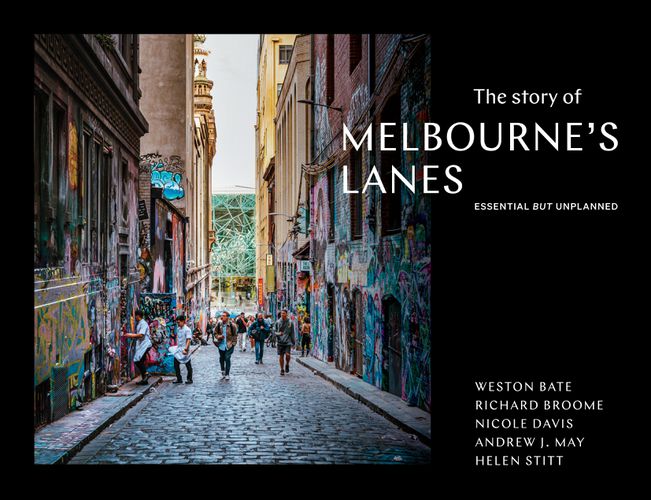Readings Newsletter
Become a Readings Member to make your shopping experience even easier.
Sign in or sign up for free!
You’re not far away from qualifying for FREE standard shipping within Australia
You’ve qualified for FREE standard shipping within Australia
The cart is loading…






This is a history of Melbourne's lanes over 180 years from their creation in the 1840s until 2024. Every Melburnian should have a copy of this book. It is a gorgeous lavishly-illustrated hardback.
"Melbourne … started as an ideal colonial grid of city blocks —at once dextrous but invasive—overlaid onto the undulating landscape of the Wurundjeri and Boon Wurrung peoples. It was then voraciously cut, sliced, sometimes reformed, then sliced and sliced again. As historian Weston Bate described in the first iteration of this book in 1994, an “essential but unplanned” network of tiny streets, by necessity, was inserted to service in the most practical sense the workings of these narrow slivers of land that required light, air, servicing and delivery from behind or from the side. That functional ‘back’ story is what lends special nuance to Melbourne’s lanes and their subsequent and alternately seamy or gleaming histories: of crime, prostitution and opium dens, as implicit racial ghettoes, of hidden pearls containing elegant arcades, and, more recently, the institutionalised resurgence of Melbourne’s lanes as prized urban spaces, now touted as models of what the word ‘urban’ might mean in an Australian setting."
“Melbourne’s laneways have always been dynamic and always great survivors. Robin Boyd wrote in Victorian Modern in 1947 that, ‘The little lanes were the honest streets of Melbourne’. This book proves that still to be the case.”
From the Foreword by Philip Goad
Chair of Architecture, University of Melbourne
This book is an RHSV publication (in partnership with the State Library of Victoria) which expands on a popular but now well out-of-print book by historian Weston Bate, Essential but Unplanned. The Story of Melbourne’s Lanes (1994). The new book (280 pages) more than doubles the size of the old with extra chapters to bring the story of Melbourne’s lanes up-to-date. There is a multitude of new photos – both contemporary and historical, both colour and black-and-white and more comprehensive indices.
$9.00 standard shipping within Australia
FREE standard shipping within Australia for orders over $100.00
Express & International shipping calculated at checkout
This is a history of Melbourne's lanes over 180 years from their creation in the 1840s until 2024. Every Melburnian should have a copy of this book. It is a gorgeous lavishly-illustrated hardback.
"Melbourne … started as an ideal colonial grid of city blocks —at once dextrous but invasive—overlaid onto the undulating landscape of the Wurundjeri and Boon Wurrung peoples. It was then voraciously cut, sliced, sometimes reformed, then sliced and sliced again. As historian Weston Bate described in the first iteration of this book in 1994, an “essential but unplanned” network of tiny streets, by necessity, was inserted to service in the most practical sense the workings of these narrow slivers of land that required light, air, servicing and delivery from behind or from the side. That functional ‘back’ story is what lends special nuance to Melbourne’s lanes and their subsequent and alternately seamy or gleaming histories: of crime, prostitution and opium dens, as implicit racial ghettoes, of hidden pearls containing elegant arcades, and, more recently, the institutionalised resurgence of Melbourne’s lanes as prized urban spaces, now touted as models of what the word ‘urban’ might mean in an Australian setting."
“Melbourne’s laneways have always been dynamic and always great survivors. Robin Boyd wrote in Victorian Modern in 1947 that, ‘The little lanes were the honest streets of Melbourne’. This book proves that still to be the case.”
From the Foreword by Philip Goad
Chair of Architecture, University of Melbourne
This book is an RHSV publication (in partnership with the State Library of Victoria) which expands on a popular but now well out-of-print book by historian Weston Bate, Essential but Unplanned. The Story of Melbourne’s Lanes (1994). The new book (280 pages) more than doubles the size of the old with extra chapters to bring the story of Melbourne’s lanes up-to-date. There is a multitude of new photos – both contemporary and historical, both colour and black-and-white and more comprehensive indices.
See what the Readings’ team have to say on the blog, discover related events and podcast episodes.
We're excited to bring you these small press and self-published titles from local Australian authors.
Discover our latest new release fiction and nonfiction books.
Discover new Australian nonfiction books at Readings, with biography, memoir, essays and analysis.